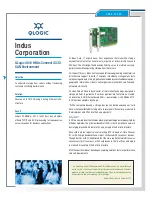
Minimizing downtime
The ability of the MPX200's to deliver a migration rate of 4TB/hr. per blade, combined with seamless
integration of the MPX200 in the SAN and data protection features such as array attributes
(source/destination), make it likely that the downtime objective will be met by offline data migration.
The following recommendations will simplify the data migration project:
•
Configure all migration jobs in the MPX200 before application downtime begins.
•
Deploy dual blade configuration in the MPX200 to achieve up to 8TB/hr. (for storage arrays that
are capable of delivering such performance).
Before application downtime
Before application downtime, follow these steps:
1.
Plan the data migration project:
a.
Create the migration checklist.
b.
Determine if a change in multi-pathing software is required.
c.
Build the LUN ID table for both the source and destination array to establish the LUN ID
relationship between the server and the MPX200.
d.
Plan to migrate together the LUNs from the same server/cluster.
2.
Configure the MPX200 in the SAN: Perform proper zoning such that the MPX200 can see ports
from both the source and destination arrays.
3.
Create the LUNs on the destination array:
• For the UNIX operating system, use the same size LUNs.
• For Windows operating systems, you may create a larger LUN.
Do not present LUNs from the destination array to the server until migration is complete.
4.
Based on the order in which LUNs should be migrated, balance the LUNs across multiple controllers
of the same array.
5.
Present the source LUNs and destination LUNs to the MPX200.
6.
Using the MPX200 user interface, assign appropriate (source/destination) attributes to the storage
array.
7.
Using the MPX200, create user-defined groups to assign the migration jobs related to the same
server in a single group.
8.
Using the user interface wizard, configure migration jobs.
During application downtime
During application downtime, follow these steps:
1.
Confirm with the storage administrator that the application and server are down, and that the
server no longer has access to the storage under migration.
2.
Remove the server access to the source storage array by changing the Fibre Channel zoning
such that server adapter ports can no longer see the source or destination array ports.
3.
Start the previously configured migration jobs.
4.
If required, install the new multi-pathing software on the server.
Data migration best practices
374
Содержание Storageworks 8100 - enterprise virtual array
Страница 20: ...20 ...
Страница 30: ...MPX200 Multifunction Router overview 30 ...
Страница 47: ...Figure 27 iSCSI controller options Remove controller MPX200 Multifunction Router 47 ...
Страница 48: ...Managing the MPX200 using HP Command View EVA 48 ...
Страница 59: ...Figure 32 Virtual disk properties Figure 33 Host details MPX200 Multifunction Router 59 ...
Страница 112: ...MPX200 iSCSI configuration rules and guidelines 112 ...
Страница 219: ...Load Balancing Enabled Array License Not Applied MPX200 Multifunction Router 219 ...
Страница 222: ...Controller Id WWPN PortId Path Status 0 20 78 00 c0 ff d5 92 e5 02 04 00 Current Optimized Offline Data Migration 222 ...
Страница 248: ...Offline Data Migration 248 ...
Страница 258: ...Diagnostics and troubleshooting 258 ...
Страница 306: ...Command referencecommand reference 306 ...
Страница 330: ... Blade number 1 or 2 Simple Network Management Protocol setup 330 ...
Страница 368: ...Saving and restoring the MPX200 configuration 368 ...
Страница 402: ...Data migration best practices 402 ...
Страница 408: ...408 ...
















































